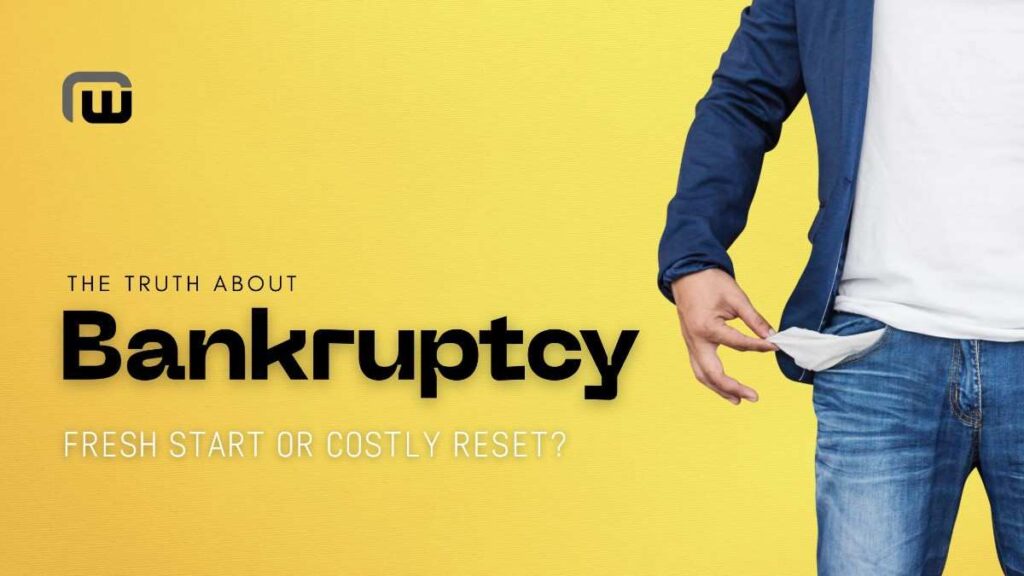Imagine you borrowed your friend’s video game, then another friend’s football, then another friend’s cycle… and suddenly you realize you can’t give them back because you broke the game, lost the football, and your cycle has a flat tire.
That’s exactly what bankruptcy is. It’s when a person or a business says:
“I borrowed too much money, and now I can’t pay it back. Help!”
The court (think of it as the referee in a cricket match) steps in, checks the situation, and makes rules so things don’t turn into a big fight. Sometimes debts are forgiven, sometimes you get more time to pay, and sometimes your stuff is sold to pay the people you borrowed from.
Lesson: Bankruptcy doesn’t mean you’re a bad person or business – it’s just a way to restart when money problems get too big.
Fun Fact: Most people who file for bankruptcy didn’t go broke because they bought too many video games—they did so because of medical bills, job loss, or big emergencies.
In this post you’ll get:
- The real advantages and real disadvantages of bankruptcy — for both people and businesses.
- A step-by-step guide to navigate it (so you don’t trip on paperwork).
- Short lessons, quotes, facts, and true-ish stories that make the whole thing easier to remember.
All written in plain, conversational English with a dash of humor because — let’s be honest — dry legal writing makes even accountants yawn.
What bankruptcy really is:

Bankruptcy is basically a legal process where the court steps in to help you sort out your debt mess. It doesn’t magically erase everything, but it gives you breathing space and a structured way to deal with what you owe. Depending on whether you’re an individual or a business, and depending on the country, it works differently.
For example:
- In the U.S. Chapter 7 means selling (liquidating) assets to pay debts.
- Chapter 13 means having a repayment plan over a few years.
- Chapter 11 is usually for bigger businesses — reorganizing so they can keep running.
Think of bankruptcy as a “legal pause button”, not a magic eraser.
Part A — Advantages for Individuals (and why they matter)
1. Collections stop immediately
Once you file, creditors must stop harassing you with calls, lawsuits, or wage cuts. It’s like suddenly turning down the volume on all the financial chaos.
Lesson: If you’re getting nonstop collection calls, filing can stop the noise — instantly.
2. Wipes out many everyday debts
Bankruptcy can wipe out unsecured debts such as credit card balances and medical bills, giving you a fresh start. Not everything is wiped, but many day-to-day consumer debts are.
Real-life mini-story (composite):
Meera had six months of medical bills after an emergency admission. The bills were crushing her retirement savings. Filing Chapter 7 cleared most unsecured medical debt and allowed her to start rebuilding without those monthly reminders. She still had to make lifestyle adjustments, but the constant phone calls stopped — and that helped her think clearly.
Lesson: Discharge frees monthly cashflow — use that breathing space to rebuild, not re-splurge.
3. Structured repayment plan (Chapter 13)
If you have steady income but a pile of debt, a court-approved repayment plan spreads payments over 3–5 years and protects assets. It’s structured, enforceable, and — crucially — avoids the uncertainty of endless creditor demands.
Lesson: If you can pay something monthly, prefer a structured plan over a chaotic scramble.
4. Emotional relief — yes, it counts
Debt wears on you. The legal structure and timelines make progress measurable. Gaining control of the process reduces stress and helps decision-making.
Quote: “Relief is not just financial — it’s psychological. A plan reduces the noise.” — bankruptcy counselor
Lesson: Don’t ignore mental health during financial crises. Speak to a counselor.
Part B — Advantages for Businesses (and why companies sometimes choose bankruptcy deliberately)
1. Reorganization and ‘breathing room’ to pivot
Businesses can use formal insolvency (like Chapter 11 in the U.S. or the CIRP under India’s IBC) to restructure debt, renegotiate contracts, and sell non-core assets while continuing operations. That’s how some companies survive and come back stronger.
Fact (India): India’s Insolvency and Bankruptcy Code (IBC) provides a time-bound process intended to balance creditor recovery and business rescue — with rules that keep evolving.
Lesson: For viable businesses, bankruptcy can be a controlled reboot — not an instant shutdown.
2. Escape bad contracts
Under many reorganization laws, a business in bankruptcy may be able to reject burdensome leases or vendor contracts — freeing cashflow to focus on what works.
Lesson: Don’t assume all contracts are permanent anchors — some can be renegotiated or let go.
3. Negotiation under one roof
Instead of chaos with dozens of creditors, bankruptcy makes everyone negotiate together in a structured process.
Lesson: It’s easier to solve problems when everyone plays by the same court rules.
Part C — Disadvantages for Individuals (the cost of the “fresh start”)
1. Long-term credit impact
Bankruptcy stays on credit reports for a long time — typically 10 years for Chapter 7 and 7 years for Chapter 13 in the U.S. — and that affects access to mortgages, loans, and sometimes rental housing.
Lesson: Expect higher interest rates and waiting periods for large loans; plan housing and car purchases accordingly.
2. Some debts won’t go away
Child support, alimony, certain taxes, and many student loans are commonly non-dischargeable. That means bankruptcy may not solve every kind of debt.
Lesson: Get a clear list of which debts can and cannot be discharged before filing.
3. Potential loss of property or lifestyle changes
Depending on exemptions in your jurisdiction, you might have to surrender non-protected assets. That could include investment properties, vehicles beyond the exempt limit, or valuable collectibles.
Learn with Real incident:
Arjun’s small rental property was secured by a mortgage he couldn’t afford; bankruptcy forced a sale and he lost the monthly rental income that was his safety net.
Lesson: Inventory assets early and understand exemptions — sometimes selling an asset intentionally (before filing) preserves other things better than a court sale.
4. Employment and housing checks
Some employers and landlords run credit checks; a bankruptcy can complicate hiring or renting for certain roles or properties. Rules vary by place and job type.
Lesson: Prepare an honest, concise explanation if asked — focus on the facts and the steps you’ve taken to fix things.
Part D — Disadvantages for Businesses (the business realities)
1. Reputation damage and lost trust
Suppliers, customers, and investors can interpret bankruptcy as instability and may move business elsewhere — sometimes permanently. Rebuilding trust takes time.
Lesson: Communicate early and honestly — silence fuels rumors.
2. Potential loss of control
During formal insolvency, management may face oversight from trustees, creditor committees, or courts; founders can lose autonomy. Professional fees (lawyers, accountants, advisors) also drain cash.
Lesson: Budget for professional fees — cheap shortcuts often cost more later.
3. Customer and employee churn
Top talent may leave for stability; customers may switch suppliers to reduce risk. The operating disruption can compound financial stress.
Lesson: Retain core employees with clear communication and short-term incentives where possible.
4. Recovery isn’t guaranteed
Even with restructuring, some firms fail because they can’t re-win market confidence or adapt to the post-reorg reality. The IBC and other systems offer paths to rescue, but recovery rates and timelines vary.
Lesson: Reorganization requires a credible plan, not just paperwork.
Part E — Step-by-Step Guide:
How to Approach Bankruptcy (so you make fewer mistakes). This is the practical checklist. Treat it like a recipe — follow the steps in order.
Step 0 — Stop, breathe, and don’t sign anything you don’t understand
If creditors call, stay calm. You do not need to respond immediately to every demand. Gathering data first beats panic. (Yes, this is step zero — the most underrated step.)
Lesson: Breathe. Paperwork is solvable. Panic makes bad deals.
Step 1 — Inventory everything (assets, debts, contracts)
Make a spreadsheet: assets, secured vs unsecured debts, monthly income, fixed expenses, leases, and co-signers. This is the map you’ll hand to your advisor. Accurate mapping prevents nasty surprises.
Lesson: A 30-minute inventory now saves weeks of court headaches later.
Step 2 — Explore alternatives (negotiation, debt counseling, consolidation)
Call lenders; sometimes they’ll accept a payment plan. Consider credit counseling, debt settlement (weigh pros/cons), or refinancing before filing. For businesses, negotiate with top suppliers and lenders — many prefer a negotiated repayment to a messy bankruptcy.
Lesson: Bankruptcy is often the last resort. Ask “what will they accept?” — negotiation costs nothing but time.
Step 3 — Get professional advice (attorney, accountant, credit counselor)
This is not the time for DIY unless the case is tiny. A lawyer will explain which debts are dischargeable, what assets are exempt, and which filing type fits your situation. For businesses, a restructuring advisor or insolvency professional is essential.
Lesson: Even one hour with an expert can save months of regret.
Step 4 — Prepare communications (employees, customers, family)
For businesses: prepare an FAQ for employees and a clear message for customers. For individuals: plan what to tell family, your landlord, or your employer if asked. Transparency (not oversharing) builds trust.
Lesson: Silence breeds panic — a single clear message prevents rumor fatigue.
Step 5 — Understand exemptions & protect what you can
Exemptions vary by jurisdiction. Know what personal property is safe (homestead exemptions, tools of trade, retirement accounts). In India, personal guarantor rules and the IBC have different implications than Western systems, so local advice matters.
Lesson: Protect essentials first: housing, basic transport, and tools that earn income.
Step 6 — File, if it’s the right move — and keep records
File carefully. Missed forms or omitted debts can cause dismissal or loss of protection. Keep digital copies of everything. The court process has deadlines — missing one can be costly.
Lesson: Paperwork discipline = legal protection.
Step 7 — During the process: keep operating routines
If you’re a business, keep fulfilling essential contracts where possible; don’t abandon customers unless absolutely necessary. If you’re an individual, keep paying non-dischargeable obligations (child support, taxes where required).
Lesson: Normal routines stabilize perception and reality.
Step 8 — After discharge: rebuild intentionally
Repair credit by making on-time payments, using secured credit products wisely, and saving a small emergency fund. Re-engage with business partners with a clear plan and evidence of stability. Patience beats speed here.
Lesson: One on-time payment starts a chain. Begin small and stay consistent.
Part F — Real stories (short & illustrative)
The café owner who kept the kettle hot:
A small café was over-leveraged on rent and equipment leases. A short, well-managed restructuring (with a negotiated rent reduction and a reworked supplier agreement) allowed the owner to stay open, keep staff, and rebuild. The lesson: negotiate early; bankruptcy isn’t always the only route.
The freelancer who used Chapter 13 as a bridge:
After a medical emergency, a freelance designer chose a repayment plan to manage debts while keeping business assets. It cost more over time but preserved her equipment and client base, letting her rebuild revenue faster.
Public note:
Large reorganizations (like historic Chapter 11 cases) show the difference between liquidation and rescue — restructuring can preserve jobs and market value, but success depends on a credible plan and market realities.
Quick Facts
- Fact: Chapter 7 often remains on credit reports for 10 years; Chapter 13 for 7 years. Plan purchases knowing this timeline.
- Fact: Some debts — child support, many taxes, and most student loans — are commonly non-dischargeable.
- Fact (India): The IBC aims for time-bound corporate insolvency resolution (subject to amendments and judicial timelines). Local rules change; check IBBI updates.
“A reset without a plan is only a delay.” — Practical finance proverb (you can quote me on that)
FAQs (short & friendly)
Q: Will bankruptcy ruin my life forever?
A: No — but it changes timelines and costs. Many people and businesses recover completely with disciplined rebuilding.
Q: Can I keep my house?
A: It depends on exemptions, mortgage status, and the filing type. Get tailored legal advice.
Q: Are student loans wiped out by bankruptcy?
A: Usually not easily — special legal tests apply and many student loans survive bankruptcy.
Final lesson & pep talk
Bankruptcy is neither a moral failure nor a glittering solution. It’s a legal tool — powerful, blunt, and filled with tradeoffs. Used correctly, it can stop the financial bleeding, protect essentials, and give you a real chance to restart. Used poorly or without a plan, it can make recovery longer and harder.
Parting quote: “A fresh start is only fresh if you learn from what caused the mess in the first place.” — Financial common sense


